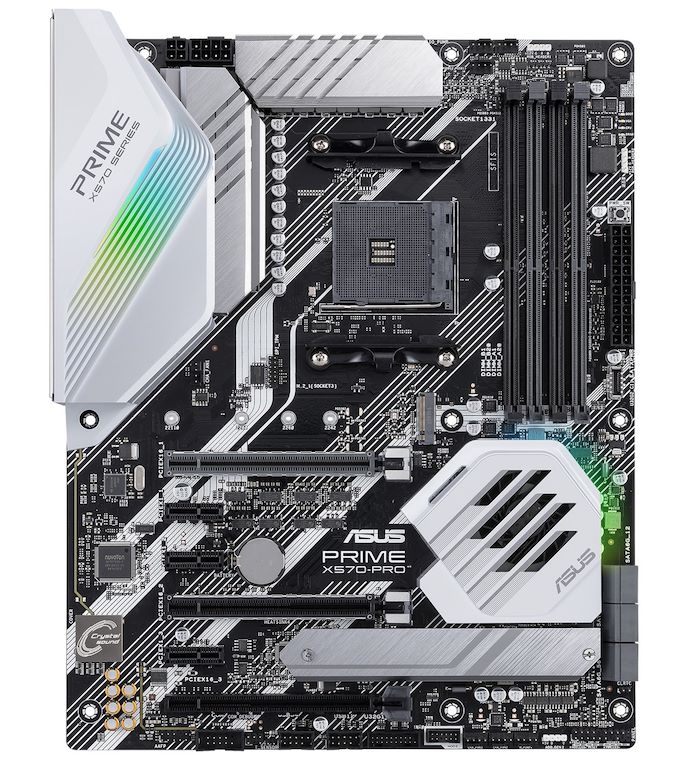The AMD X570 Motherboard Overview: Over 35+ Motherboards Analyzed
by Gavin Bonshor on July 9, 2019 8:00 AM ESTASUS Prime X570-Pro
Moving onto the ASUS Prime series of X570 motherboards, the ASUS Prime X570-Pro represents the more feature-laden of two ATX sized models; the other being the ASUS Prime X570-P. The ASUS Prime X570-Pro represents its less aggressive and non-gaming Prime range with a more subtle white and black aesthetic. The most notable aspects of the feature set include a Realtek S1220A HD audio codec, Gigabit NIC, and support for up to 128 GB of DDR4 memory.
The ASUS Prime X570-Pro offers three full-length PCIe 4.0 slots which run at x16, x8/x8, and x8/x8/x4. This allows for users to use two-way NVIDIA SLI and up to three-way AMD Crossfire multi-graphics card setups. Also present is three PCIe 4.0 x1 slots, with the board's storage capabilities coming through two PCIe 4.0 x4 M.2 slots, with the bottom slot coming with a heatsink; there are also six SATA ports with support for RAID 0, 1 and 10 arrays. In the top right-hand corner is four memory slots with support for up to 128 GB which allows users to install the 32 GB UDIMMs that has started making its way onto the market.
On the rear panel, the ASUS Prime X570-Pro includes three USB 3.1 G2 Type-A, one USB 3.1 G2 Type-C, and four USB 3.1 G1 Type-A ports. Adopters of AMD's impending Ryzen 3000 APUs and the Ryzen 2400/2200G will appreciate the HDMI and DisplayPort video outputs. There is also a PS/2 keyboard and mouse combo port, an Intel I211-AT Gigabit powered Ethernet port, and five 3.5 mm audio jacks and S/PDIF optical output driven by a Realtek S1220A HD audio codec.
The ASUS Prime X570-Pro has an MSRP of $250 and is more suited to users looking to avoid the swathe of gaming-themed models on the market. What the Prime series offers is elegant and neutral designs, which would actually look quite good with some RGB to make the white rear panel cover pop. There's support for two-way NVIDIA SLI and three-way AMD CrossFire too so users looking to build a more subtly styled gaming system can do so.












225 Comments
View All Comments
icf80 - Thursday, July 25, 2019 - link
All x570 boards supports: 4 x DDR4 DIMM sockets supporting up to 128 GB (32 GB single DIMM capacity) of system memorycroc - Friday, July 26, 2019 - link
Now find me one of these ddr4 1x32 dimms @ 3400 speed to support the speed of the CPU. What they support and what I can buy are often two different things All x299 boards support DDR4 up to 4200, at whatever size you can afford, with quad channel support. And there are 8 dimm slots...Inexpensive is often not cheap. Expensive is often cheaper than the non-existant.
CoachAub - Thursday, July 25, 2019 - link
I have an Aorus AX370 Gaming 5 mobo. With the latest BIOS update for Ryzen 3000 series (f40), I now have the option to select PCI-e 4.0. It has had 3.0 as an option as long as I can remember. It seems some mobo mfg are supporting it, even though AMD won't officially.max347 - Friday, August 2, 2019 - link
Release date on the Crosshair Impact?madseven7 - Saturday, August 3, 2019 - link
In your chart of motherboards listing biosflashback you missed the ASUS ROG Strix X570-E Gamingsoltys - Wednesday, August 7, 2019 - link
According to Asrock website, ASRock X570 Steel Legend has ALC1220dforrestvc - Sunday, August 11, 2019 - link
Will there being only three audio jacks prevent me from properly connecting a 5.1 speaker system?svan1971 - Saturday, August 17, 2019 - link
Why are the boot times with pcie 4.0 m.2 so dam slow ? My 5 year old Asrock boots 3 times faster?Tinkertron - Sunday, August 18, 2019 - link
I still haven't seen this board hit the market yet. ASRock has release 2 version and Gigabyte has 1 on the mini-ITX release already. I also notice that the ROG Strix doesn't show a fan cooled over the chipset. All the makers are adding fans over the chipset. How is ASUS getting away without doing this? Could this be the reason why ASUS hasn't release theirs yet?Crashing Bore - Sunday, December 8, 2019 - link
The Gigabyte AORUS Ultra with 3rg gen ryzen delivers pcie4 x16 + PCIE4 x8 + PCIE4 x4 for its three PCIE 16 slots - not 16/8+8/8+8+4 as described - it is 16+8+4 full time, regardless of the slots populated. This is so also for other boards in their stack, and offers point of differentiation allowing later population of, say, thunderbolt3 in the second slot without slow down the main graphics card pipeline.